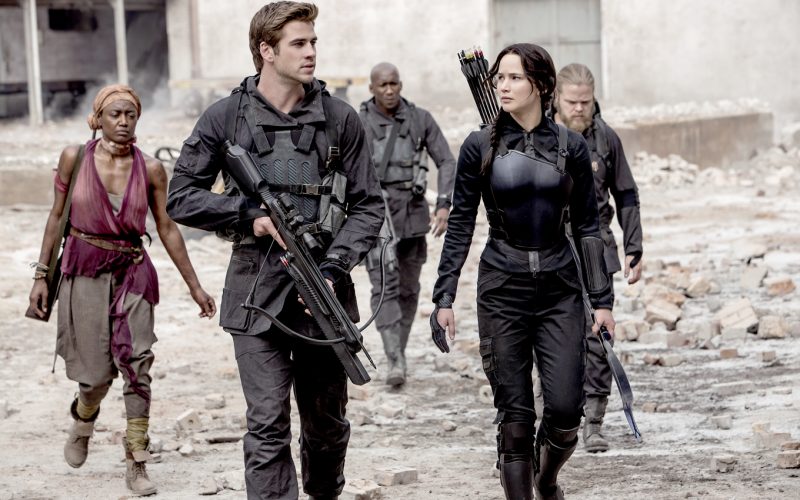At some point early on in Mockingjay: Part 1, however, I stopped thinking about the obvious cash grab to which this installment amounts and started becoming genuinely enveloped in its downbeat, affecting narrative. At the same time, the most overwhelming emotion I felt after the credits rolled was an enthusiasm to see next year’s Part 2. Fitting, that the movie focused on Katniss and a group of rebel filmmakers’ escapades to capture some effective propaganda footage to rouse the districts of Panem for the upcoming class war. In effect, the film becomes an effective piece of propaganda itself, rousing the audience for the conclusion of its story.
Mockingjay picks up soon after Catching Fire left off, with Katniss Everdeen (Jennifer Lawrence) recovering in the underground rebel strong-hold of District 13 after her class riot-inducing choice to strike out against the Capital City’s cruel Hunger Games by firing her arrow at the tournament’s force field. Soon she makes her way home to District 12 to survey its total annihilation and genocide — caused by the regime in response to her act of insurrection.
The film sets itself up as the first part of a revenge epic, with Katniss somberly surveying the oppressive regime’s violent attempts to quell the simmering rebellion while whipping up herself and her brothers in arms to rise up against their oppressors. In this respect, the movie proves to be satisfying in the same way that Kill Bill, Vol. 1 was. The story allowing the viewer to spend an entire movie empathizing with the slights against its protagonist while teasing us with action that satisfies our growing blood lust. Especially when the proletarians of one district blow up a dam that gives Capital City its electricity.
The evil President Snow (a quietly threatening Donald Sutherland) and the rest of his obscenely wealthy city are portrayed as cartoonishly villainous. Any empathy for their motivations—other than propping up the status quo at all costs—is not even an afterthought here. If there’s something a little on the nose about a film released in this class-tension filled political climate fanning the wealth-inequality flame, then there’s also something in its black and white representation of the ruling class that is satisfying in an immediate, propaganda-like way. This portrayal also serves to provide the film’s story with a worthy, morally despicable arch villain.
As usual in this franchise, the cast is uniformly solid. With the exception of Lenny Kravitz’s Cinna, the Hunger Games veterans are back, with some being demoted to just a few scenes (Woody Harrelson as Haymitch, Josh Hutcherson as Peeta, Elizabeth Banks as Effie) and others being promoted to full-on supporting players (Liam Hemsworth as Gale, Jeffrey Wright as Beetee).
The late Phillip Seymour Hoffman sees the biggest increase in screen time, who once again injects an ancillary role with ambiguity, warmth, and humor. The notable newcomer to the cast is Julianne Moore, who plays District 13’s weary President Coin. At the center once again is Jennifer Lawrence, who finds enough gravity in the lead role to allow the injustices committed against her to feel real and outrageous enough for the audience to share in her growing sense of responsibility to take down President Snow and his army.
The aforementioned propaganda subplot early on in the movie turns out to be its most interesting, with rebel leaders Hoffman and Moore plotting and arguing about how best to posture Katniss in order to, as Hoffman puts it, “keep the flame of the revolution going.” The appeal of these scenes is two-fold; they serve as an interesting behind the scenes look at the crass image self-consciousness that is required to galvanize an army while also serving as the film’s one moral grey area. It asks the viewer if the puppeteering of Katniss performed by Hoffman and Moore make them friends or just another power-starved group that wields Katniss’s popularity for their own gain. On the other hand, the film’s climactic sequence—a covert mission to rescue Peeta from the grips of Capital City—feels unnaturally magnified, an important scene blown up into a defining scene because of its contrived position as the stopping point between Part 1 and Part 2.
Despite my grievances, which are aimed mostly at the studio and not at the creative team that put this movie together, I was entertained by Mockingjay Part 1 from start to finish. It shows once again that the Hunger Games is the real deal in the always growing super-blockbuster-based-on-a-young-adult-novel-series category. It also shows itself to be the most successful two-hour teaser trailer in the history of the medium.




